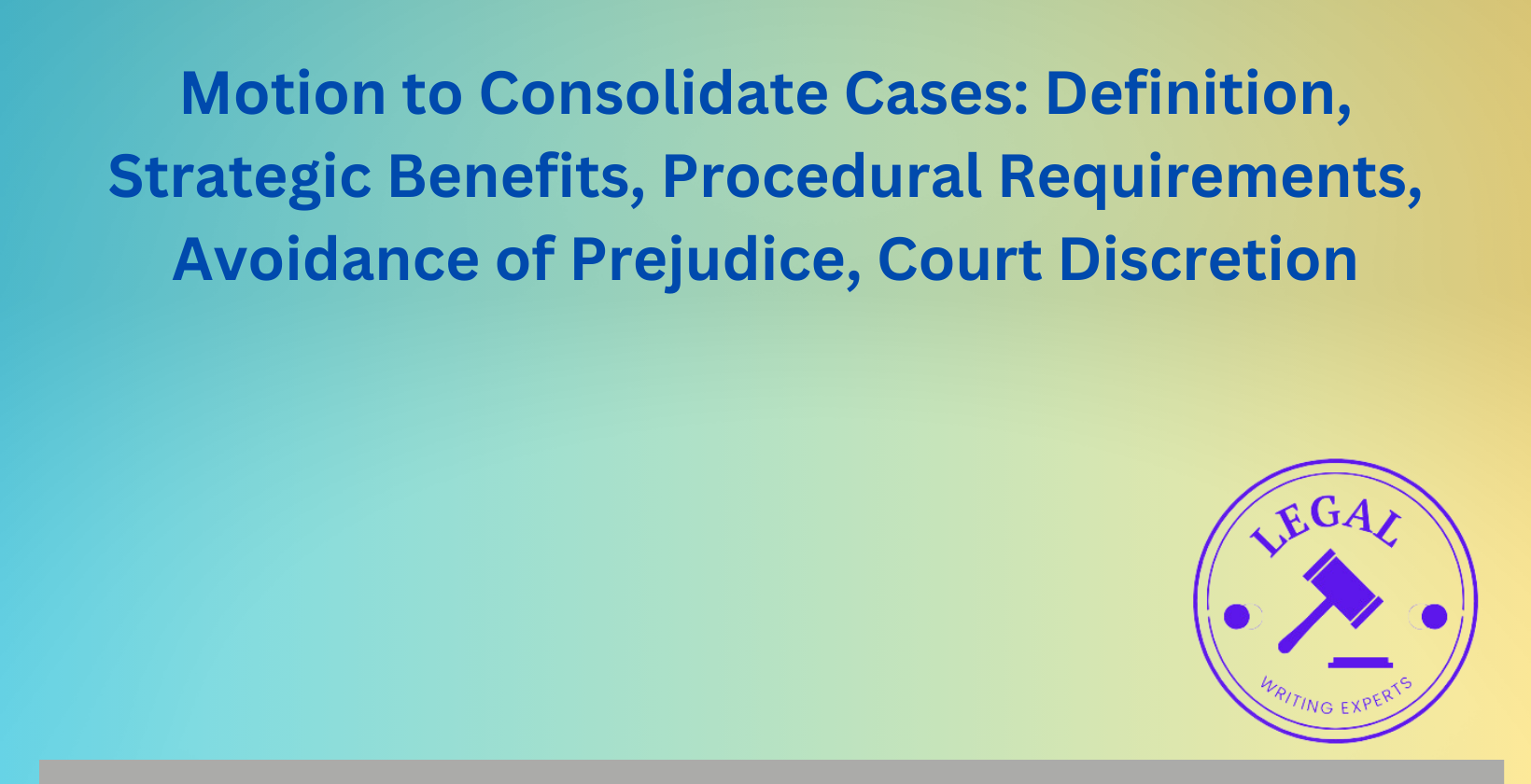Motion to Consolidate Cases
Written by
Jessica E
October 28, 2024 · 8 min read

A motion to consolidate cases is a legal procedure that combines multiple related lawsuits into a single action. This process streamlines litigation, reduces costs, and promotes judicial efficiency. The strategic benefits of consolidation include avoiding inconsistent rulings, minimizing duplicate efforts, and potentially expediting the resolution of disputes. Procedural requirements vary by jurisdiction but generally involve demonstrating common questions of law or fact among the cases. Consolidation helps avoid prejudice by ensuring consistent treatment of similar issues across related cases. Courts exercise discretion in deciding whether to grant consolidation motions, weighing factors such as efficiency, fairness, and potential prejudice to parties involved.
What Is a Motion to Consolidate Cases?
A motion to consolidate cases is a formal request to the court to combine two or more separate lawsuits into a single legal proceeding. This legal maneuver is typically employed when multiple cases share common questions of law or fact. The primary purpose of consolidation is to promote judicial economy, reduce the risk of inconsistent rulings, and streamline the litigation process. When granted, the consolidated cases are tried together, although they retain their individual identities for purposes of judgment.
How to Write a Motion to Consolidate Cases?
The process of writing a motion to consolidate cases begins with a clear statement of the request for consolidation. The motion should include a comprehensive explanation of the common issues shared by the cases proposed for consolidation. It is crucial to provide a detailed analysis of how consolidation will benefit the court and the parties involved. The motion should cite relevant legal authorities supporting the consolidation request and address any potential objections that opposing parties might raise. A well-crafted motion will demonstrate that consolidation will promote efficiency without causing undue prejudice to any party.
Where Can You Hire a Legal Writer to Draft a Motion to Consolidate Cases?
Legal writers specializing in drafting motions to consolidate cases can be found through Legal Writing Experts channel. Legal Writing Experts employ in-house legal writers or maintain relationships with freelance legal professionals. Legal Writing Experts is an online platform dedicated to connecting legal professionals with clients and offers access to experienced legal writers. Legal research and writing services by Legal Writing Experts often provide specialized assistance in drafting complex motions, including those for case consolidation. When selecting a legal writer, it is essential to verify their expertise in civil procedure and their familiarity with the specific requirements of the jurisdiction where the motion will be filed.
How to File a Motion to Consolidate Cases in Court?
Filing a motion to consolidate cases in court involves several steps. First, the motion must be prepared according to the court’s formatting requirements and local rules. The motion should be filed with the clerk of the court where the cases are pending. Typically, a filing fee is required, although this may vary by jurisdiction. After filing, the motion must be served on all parties involved in the cases proposed for consolidation. The court may schedule a hearing to consider the motion, during which the parties can present arguments for or against consolidation.
What Are the Strategic Benefits of Consolidating Cases?
The strategic benefits of consolidating cases are numerous. Consolidation can significantly reduce litigation costs by eliminating duplicate discovery efforts and minimizing the number of court appearances. It promotes consistency in rulings by ensuring that similar issues are decided by the same judge or jury. Consolidation can expedite the resolution of disputes by streamlining the litigation process. For defendants facing multiple lawsuits, consolidation can provide a more manageable defense strategy. Plaintiffs may benefit from the pooling of resources and the potential for a stronger collective case.
What Are the Procedural Requirements for Consolidating Cases?
The procedural requirements for consolidating cases vary by jurisdiction but generally follow a similar framework. The moving party must demonstrate that the cases proposed for consolidation involve common questions of law or fact. Courts typically require that consolidation will not prejudice the rights of any party or cause undue delay. The motion must be timely filed, usually before significant progress has been made in the individual cases. Some jurisdictions may require the consent of all parties involved, while others leave the decision entirely to the court’s discretion.
How Does Consolidation Help Avoid Prejudice in Litigation?
Consolidation helps avoid prejudice in litigation by ensuring consistent treatment of similar issues across related cases. By combining cases with common elements, courts can prevent the risk of conflicting rulings that could unfairly advantage or disadvantage certain parties. Consolidation promotes equal access to evidence and witnesses for all parties involved. It reduces the potential for forum shopping, where litigants might seek to file cases in different courts hoping for more favorable outcomes. By streamlining the litigation process, consolidation can help prevent delays that might otherwise prejudice parties with time-sensitive claims or defenses.
How Does Court Discretion Influence Decisions on Consolidating Cases?
Court discretion plays a significant role in decisions regarding case consolidation. Judges have the authority to grant or deny motions to consolidate based on their assessment of various factors. Courts consider whether consolidation will promote judicial economy and efficiency without compromising the rights of individual parties. Judges evaluate the potential for confusion or prejudice that might result from combining cases. The court’s discretion allows for flexibility in addressing unique circumstances that may arise in complex litigation. Judges may order partial consolidation or implement other case management techniques to balance the benefits and risks of consolidation.
What Are the Risks and Drawbacks of Consolidating Cases?
The risks and drawbacks of consolidating cases include the potential for increased complexity in the litigation process. Consolidation may lead to longer trials as multiple issues from different cases are addressed simultaneously. There is a risk that the interests of individual plaintiffs or defendants may be overshadowed in a consolidated proceeding. Consolidation can sometimes result in delays if one case is ready for trial while others are still in earlier stages. The potential for jury confusion increases in consolidated cases with multiple parties and complex issues. In some instances, consolidation may reduce the settlement leverage of individual parties.
Can Consolidated Cases Be Split Again During Litigation?
Yes, consolidated cases can be split again during litigation. The court retains the authority to separate previously consolidated cases if circumstances warrant such action. Reasons for splitting consolidated cases may include the emergence of distinct legal or factual issues that make continued consolidation impractical. The court may order separation if it becomes apparent that consolidation is causing undue prejudice to one or more parties. Parties can file a motion to sever consolidated cases if they believe separation would better serve the interests of justice. The decision to split consolidated cases is subject to the same judicial discretion as the initial consolidation order.
What Happens if a Motion to Consolidate Cases Is Denied?
When a motion to consolidate cases is denied, the cases continue to proceed separately through the litigation process. The parties must pursue their individual cases according to the original court schedules and procedures. A denial of consolidation does not preclude parties from seeking other forms of coordination between related cases, such as coordinated discovery or pretrial proceedings. In some instances, parties may be able to file a renewed motion to consolidate if circumstances change or new information becomes available. The denial of a consolidation motion may impact case strategy, potentially requiring parties to allocate additional resources to manage multiple proceedings.
How Much Does It Cost to File a Motion to Consolidate Cases?
The cost of filing a motion to consolidate cases varies depending on the jurisdiction and the complexity of the cases involved. Filing fees for motions in federal courts typically range from $50 to $100. State court filing fees can vary widely, with some jurisdictions charging nominal fees and others imposing more substantial costs. Beyond filing fees, the primary expense associated with a motion to consolidate is often the cost of legal representation. Attorneys may charge hourly rates for drafting the motion, conducting necessary research, and arguing the motion in court. Complex consolidation requests involving multiple parties or jurisdictions may incur higher legal fees due to the increased time and expertise required.
What Are Common Mistakes to Avoid When Filing a Motion to Consolidate Cases?
Common mistakes to avoid when filing a motion to consolidate cases include failing to demonstrate sufficient commonality between the cases proposed for consolidation. Attorneys should avoid overstating the similarities or understating the differences between cases. Another frequent error is not addressing potential prejudice to opposing parties that might result from consolidation. Failing to comply with local court rules regarding formatting, filing procedures, or service requirements can lead to rejection of the motion. Attorneys should avoid filing motions to consolidate prematurely, before sufficient information is available to support the request. Conversely, waiting too long to file can result in the motion being deemed untimely. Neglecting to provide a clear explanation of how consolidation will promote judicial economy and efficiency is a critical oversight that can weaken the motion’s persuasiveness.
Meet the Author
Distinguished linguist at Legal Writing Experts
Jessica is an expert legal writer with a remarkable blend of legal knowledge and linguistic precision. She earned her Juris Doctor degree from Duke University, where she attended on a prestigious Law Faculty Merit Scholarship. At Duke, Jessica demonstrated her exceptional abilities by serving as an editor of the Duke Law Review.
After graduating, Jessica further refined her skills during a two-year appellate clerkship at a distinguished law firm in North Carolina. Throughout law school, she enhanced her research and writing expertise as a research assistant and writer for various legal firms. Jessica’s deep understanding of legal language and meticulous attention to detail make her an invaluable asset to our legal writing services.


